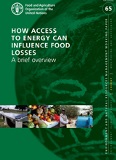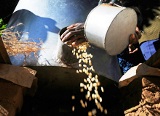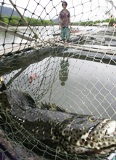Food Loss Related News
Food Loss Related Publications

Food losses and waste: how Brazil is facing this global challenge?
01/01/2017
By 2017, Brazil seems to have finally awakened to the problem of food loss and waste. In this article, we resume the topic started in the article “Postharvest losses of perishables in Brazil: what do we know so far?”

Etat des lieux sommaire des pertes post récolte au niveau des filières tomate, ananas et pisciculture au Bénin
01/01/2017
Dans sa logique de facilitation des relations d’affaires entre ses différentes institutions et partenaires, l’ambassade des Pays Bas près le Bénin a servi de pont pour établir la collaboration entre le programme ACMA, Post Harvest network (PHN) et le réseau AgriProFocus (APF). L’objectif de cette mise en relation est d’explorer...

Purchasing Patterns and Consumer Level Waste of Fruits and Vegetables in Urban and Peri-Urban Centers in the Philippines
01/01/2017
In Food and Nutrition Sciences, Vol.8 No.10, 2017 | Fruits and vegetables are inherently perishable hence they are considered as one of the most wasted categories of food. While several studies have been conducted to assess consumer level waste of fruits and vegetables, few have been conducted in developing countries.

Food loss in grain value chains. Causes and recommended solutions
01/01/2017
An Infographics that illustrates the different steps along the studied value grain chains by food loss causes and recommended solutions, as a tool to support training and dissemination of good practice at field level. A joint RBA project has studied and identified the main causes and solutions for food loss and waste reduction along sorghum, beans, maize, cowpea and rice value chains in Burkina Faso, DRC and Uganda.

Technical and investment guidelines for milk cooling centres
30/06/2016
This book aims to serve as a reference and guideline document for small and microenterprises, small-scale organizations, non-governmental organizations, government agencies, the manufacturers of bulk milk coolers for small and microenterprises, and teaching and educational institutions offering courses in dairying, food sciences and technology.

Developing the cold chain in the agrifood sector in sub-Saharan Africa
01/01/2016
This policy brief is based on the proceedings of the Re- gional workshop on the use of the cold chain in the development of agriculture and agro- industries in sub-Saharan Africa, organized in Yaoundé (Cameroon) in June 2012. The workshop brought together speakers from diverse backgrounds to analyse findings from...

Announcing YieldWise: How the World Can Cut Food Waste and Loss by Half
01/01/2016
Over the last three years, we have explored interventions as part of our ongoing work to strengthen African farmers like Sella. We learned that there are many existing solutions—yet these solutions were not reaching smallholder farmers. We are dedicated to re-aligning actors and interventions, such as expanding proven technologies that...

How access to energy can influence food losses. A brief overview
01/01/2016
This report focusses on understanding how access to energy is a key factor affecting the magnitude of food loss in developing countries. It identifies the main stages of the food value chain where increasing access to energy can play a dominant role in reducing food losses directly.

La conservation des grains après rècolte
01/01/2016
La totalité de la production agricole idestinée à l’alimentation humaine ne parvient pas à ses destinataires en raison de pertes au cours de la phase dite de « post-récolte » qui comporte les étapes entre la récolte et la transformation des produits pour l’alimentation. Dans le contexte d’augmentation de la...

Promoting Food Security and Safety via Cold Chains - Technology options, cooling needs and energy requirements
01/01/2016
The purpose of this concept paper is to present different existing and potential cold chains for food products and to give an overview of existing challenges and possible solutions towards better cold chain coverage, improved cold chain management and reduced food losses in developing countries.

Empowering women in Afghanistan. Reducing gender gaps through Integrated Dairy Schemes
03/04/2015
This publication assesses the gender impacts of the Integrated Dairy Schemes (IDS) approach in Afghanistan and results from a field mission to Afghanistan, interviews with beneficiaries and key public and private stakeholders, combined with analysis of secondary data. Findings confirmed that the IDS approach has a sustainable positive impact on rural Afghan women and their families

Technical manual for the construction and use of family-sized metal silos to store cereals and grain legumes
01/01/2015
The Technical manual for the construction and use of family-sized metal silos to store cereals and grain legumes was produced in the Division of Rural Infrastructure and Agro-industries (AGS) of FAO as a significant technical contribution to preventing losses in the post-harvest phase of grains and cereals.

A Review of Methods for Estimating Grain Post-Harvest Losses
01/01/2015
This present report is a review of relevant literature, which includes publications manuals, methodologies and guidelines on estimating post-harvest losses of the Food and Agriculture Organization of the United Nations (FAO), as well as publications by other institutions, international organizations and relevant country experiences on estimating post-harvest losses.

Strengthening the Performance of Post-Harvest Systems and Regional Trade in Small-Scale Fisheries: Case Study of Post-Harvest Loss Reduction in the Volta Basin Riparian Countries
01/01/2015
This report summarizes the main activities implemented under the NEPAD–FAO Fish Programme (Support to the Implementation of the Strategy for Fisheries and Aquaculture in Africa-NFFP), focusing particularly on its Output B4 “Mechanisms established for improving the performance of the fisheries and aquaculture post-harvest chain and regional trade”.
-.tmb-th600x450.jpg?Culture=en&sfvrsn=aff0f853_1)
Guide for developing and using the FAO-Thiaroye Processing Technique (FTT-Thiaroye)
01/01/2015
After a general overview of the comparative advantages of the FTT-Thiaroye, detailed information are provided to any development practitioner or any interested person or entity on the different components/devices, the supply in fuel, how to use and operate the FTT-Thiaroye, and how to care and maintain it.

Regional Strategic Framework Reducing Food Losses and Waste in the Near East & North Africa Region
01/01/2015
This document outlines a Regional Strategic Framework for reducing food losses and waste in the region. It responds to the FAO NERC-31 (in May 2012) recommendation calling on FAO to “assist member countries in addressing the key challenges of reducing food waste and losses by conducting comprehensive studies".

Towards a specific post-harvest loss management policy and strategy for Mozambique
01/01/2015
The Agriculture Sector in Sub-Saharan Africa (SSA) is characterized by poor post-harvest practices. Post-harvest losses (PHL) in SSA are the highest in the world (PHL) amounting to between 26% and 36%. This corresponds to 120-170kg/capita year of production losses of edible parts of the food. Poor post-harvest practices are related...

Oilseeds | Post-harvest operations
20/04/2014
Oilseeds such as mustard, Niger seed, rape, sesame, soybean or sunflower offer a range of opportunities for small farmers, particularly in sub-Saharan Africa. Oilseed crushing can range from a large industrial scale to manual processing on farm as a small scale agro-enterprise. Home utilization of the edible oils is of great nutritional value and the protein rich by-product “cake” is fed to livestock.

Papaya: Post-Harvest Operations
04/03/2014
Papaya (Pawpaw) is an early-bearing, space-conserving, herbaceous crop requiring a tropical climate. It is fast growing and has a single straight or sometimes branched stem reaching 2-10 m height. With the development of better cultivation techniques, new varieties, improved crop handling and post-harvest technologies, papaya is gaining importance in the world tropical fruit market.

Appropriate food packaging solutions for developing countries - New edition
03/03/2014
The study was undertaken to serve as a basis for the international congress Save Food! taking place from 16 to 17 May 2011, at the international packaging industry fair Interpack2011 in Düsseldorf, Germany. It brings to the attention of the international packaging industry the constraints faced by the small- and medium-scale food processing industries in developing countries to obtain access to adequate packaging materials which are economically feasible.
